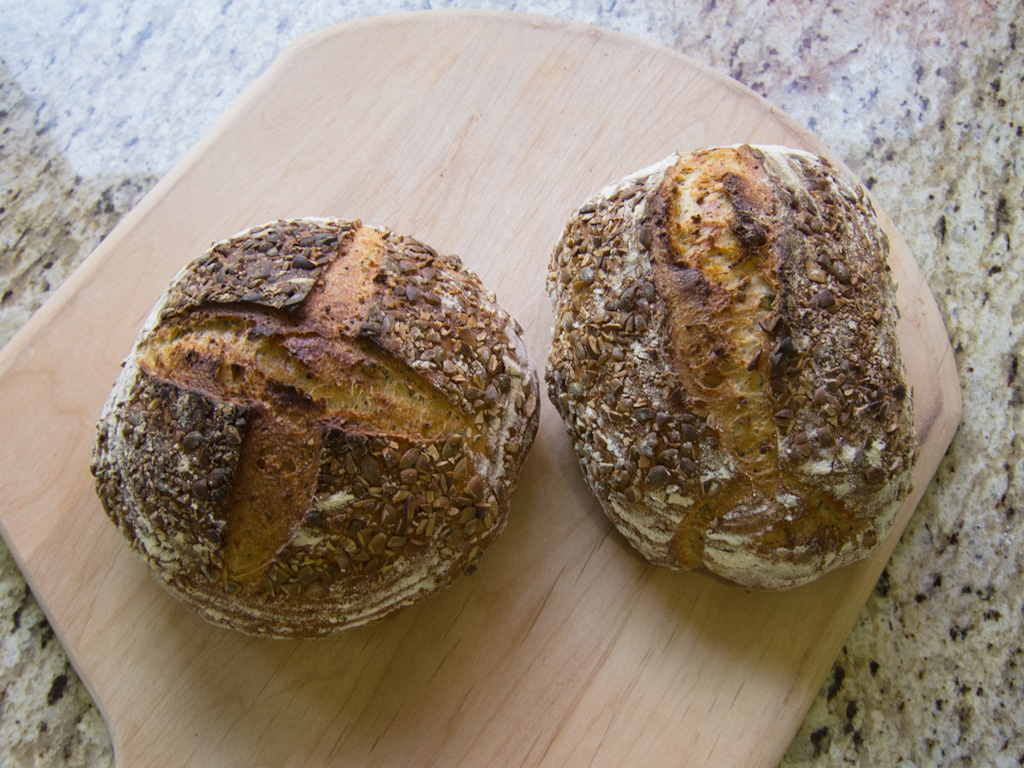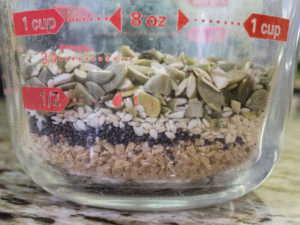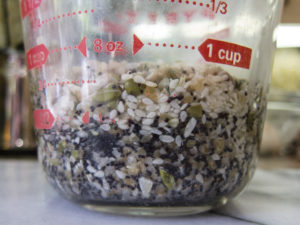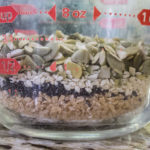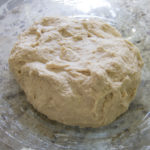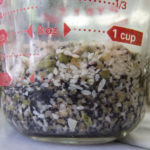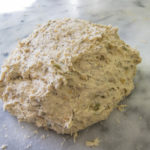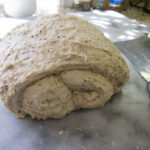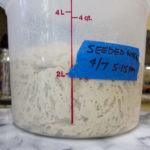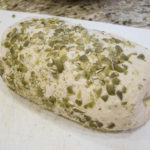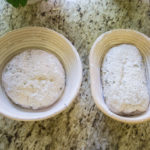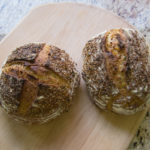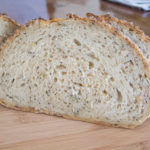Loaf 38 – A Seeded Whole Wheat Original
Loaves 9 and 10 were Seeded Whole Wheat loaves using a recipe from the first bread class I took at Sur La Table. They were terrible failures, though the one we made in class was excellent. I still don’t know what we did in class that wasn’t reflected in the recipe.
Now that I have basic breads down I decided it was time to revisit that loaf and see if I could get it right. The first thing I did was to translate the recipe to weights instead of volumes and figure out the baker’s percentages. There were a couple of things that stood out to me:
- It has a low hydration at 43%, which is lower than most other recipes I have.
- There is very little salt in it – most recipes end up around 2% (of the weight of the flour), but this recipe has 1%.
We made a nice seeded sourdough wheat bread in my SFBI class, and a book called “The Tassajara Bread Book” given to me by a friend also had a similar recipe in it. I decided to take the best of each recipe and make my own version. My first original recipe!
Here’s what I decided to do:
| % | |
| Flour | 75% |
| Wheat Flour | 25% |
| Salt | 2% |
| Yeast | 1% |
| Water | 67% |
| Total | 170% |
I used the seed mixture from the original recipe, but varied the portions a bit. I settled on:
| % | |
| Cracked Wheat | 40% |
| Poppy Seeds | 10% |
| Sesame Seeds | 10% |
| Sunflower Seeds | 10% |
| Pumpkin Seeds | 30% |
And finally, the total weight of the seeds was set at 33% the weight of the combined flours. You can do the math from there (I used my Excel Bread Calculator!).
An important step was to soak the seeds in an equivalent weight of water for 45 minutes before mixing the dough. The seeds will absorb a lot of water, effectively stealing it from the flour. I ran through the math, and to give the seeds this much water is equivalent to hydrating the flour to 84%. I think one of the issues with my original recipe is that the dough was already not heavily hydrated and the seeds soaked out even more of the water – perhaps in class the seeds were soaked first (like they were in my SFBI class).
After the seeds were soaked I mixed the dough (without the seeds) and let it rest for five minutes. It was a pretty stiff dough at 67% hydration. I then kneaded in the seeds, which took about five more minutes to get them evenly incorporated. The extra liquid softened up the dough quite a bit, so I let it rest for 10 minutes and then did a stretch and fold. This pulled everything together beautifully and I put it in the refrigerator overnight.
As a side note here, I’m really happy that I’m starting to develop a real feel for the dough. I knew what it was supposed to look and feel like, and when it didn’t I knew what to do. Very cool. That took about 35 batches of bread to develop.
The next morning I removed the dough, which had risen between 2x and 3x overnight, and preshaped two boules. I let those rest for about five minutes and then shaped them a bit more to get a stiff coating, wetted them, rolled them in chopped pumpkin seeds, and banished them to bannetons. They proofed for 1 1/2 hours, and then headed to the oven. I baked them hearth-style with steam at 450°. It took 30 minutes to reach 200° internally, then I turned off the oven and cracked the door, leaving them in for another 10 minutes.
The final loaves were very good. Two of us ate them both in two days with every meal.
Lessons
- The only change I would make to the recipe is to add some honey to it, like the original recipe had. For this amount of bread the recipe used 3 ounces, so that’s what I’d start with. The extra sweetness to balance the whole wheat would have been nice.
- The loaves also seemed a bit undercooked in the middle bottom, even though the internal temperature was at 200°. I think the size of the loaves and their higher density than the artisan loaves I’ve been making keep them from baking as quickly. Next time I’ll try baking them longer at a lower temp (maybe 400° instead of 450°) so the crust doesn’t brown as fast.
- A mix of dry seeds
- 67% hydration whole wheat dough
- Hydrated seeds
- Seeds mixed in made it a sticky dough
- After a stretch and fold
- Doubled in size overnight in the fridge
- Shaped and rolled in pumpkin seeds
- Shaped and rolled in pumpkin seeds
- Top (and seed) side down in bannetons
- Out of bannetons, scored, ready to bake
- Fresh from the oven
- Cross section of crumb

